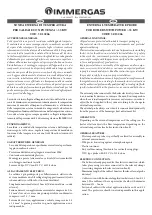
Operation information
7
Uni Condens 8000 F – 6720867069 (2016/10)
Furthermore, the following points must be observed when selecting
burner or burner control unit:
• Gas burners must be modulating and have modulating control.
• Oil burners used with boilers with an output of 70 kW or more must
be implemented as 2-stage burners and have at least a 2-stage
control.
• The control range of the burner at a boiler from an output of > 90 kW
must be at least 1:1.8 (i.e. the low load of the burner must not exceed
55%). The ignition load of the burner must also not exceed 55%.
• The burner control must ensure that the burner is switched to low
load before a controlled shutdown.
• The output of the burner must only be controlled by the control unit.
Automatic start up of the burner at full load following a burner
demand without taking the requested load into account is not
permitted!
Burner selection and settings
The sizing and settings of the burner have a significant influence on the
service life of the heating system. Every load cycle (burner on/off)
causes thermal stresses (loads on the boiler shell).
The number of
burner starts must therefore not exceed 15,000 per year.
The purpose of the following recommendations and settings is to ensure
that this figure is not exceeded.
If this figure is however exceeded:
▶ Get in touch with the sales or customer service department of the
manufacturer.
It must be possible to check the number of burner starts, e.g. at the user
interface, third-party control unit, building control system or burner
control unit.
▶ Set the burner output as low as possible.
Set the burner to the rated
heat input QN (Hi) specified on the data plate as a maximum.
Never overload the boiler!
▶ Take fluctuating net calorific values of the gas into account; check the
maximum value with the gas supply utility.
▶ Calculate the gas throughput at the burner based on the maximum
net calorific value and set accordingly at the burner.
▶ Only use burners that are suitable for the specified fuels.
▶ Ensure that the oil burner used is suitable for low sulphur fuel oil
(otherwise corrosion from metal dusting may occur). Observe the
burner manufacturer's instructions.
▶ Burners must only be adjusted by a contractor.
To be able to adjust the fuel throughput, install a fuel meter (gas and/or
oil flow meter) that can be checked even in the lower load range of the
burner. The fuel meter should be installed near the boiler and only
measure the quantity of fuel used by the corresponding boiler.
3
Operation information
When installing and operating the heating system:
▶ Observe country-specific standards, regulations and guidelines.
▶ Observe the information on the data plate of the boiler.
3.1
Combustion air quality
▶ To avoid corrosion, keep the supply of combustion air free of
corrosive substances (e.g. halogenated hydrocarbons that contain
chlorine or fluorine compounds).
▶ Never use or store chlorinated cleaning agents or halogenated
hydrocarbons (as contained in spray cans, solvents or cleaning
agents, paints and adhesives, for example) in the installation
location.
▶ Keep the combustion air supply free of dust.
▶ If building work is taking place in the installation location and creating
a lot of dust, shut the boiler down and cover it. A burner
contaminated during building work must be cleaned before
commissioning.
3.2
Water quality of the heating water
The quality of the fill and top-up water is an essential factor for increased
efficiency, functional reliability, long service life and for maintaining the
operational readiness of a heating system. If the system is filled with
water that has a high calcium hardness, this will be deposited on the heat
exchanger surfaces and will restrict the transfer of heat to the heating
water. As a result, the wall temperatures of the stainless steel heat
exchanger surfaces will rise and the thermal stresses will increase (loads
on the boiler shell).
The quality of the fill and top-up water must therefore satisfy the
specifications in the enclosed operator's log. The water quality must be
documented in the operator's log.
If the operator's log is not maintained or is missing, the warranty will be
invalidated.
If the operator's log is not included in the scope of delivery, contact the
address on the back of these instructions.
Water treatment must generally be carried out for boilers > 600 kW,
irrespective of water hardness and the fill and top-up water quantity.
3.3
Using antifreeze
Chemical additives that are not certified as harmless by the
manufacturer must not be used.
Antifreeze based on glycol has been used in heating systems for many
years, for example Antifrogen N manufactured by Clariant.
The use of other types of antifreeze should not be a cause for concern if
the product is comparable with Antifrogen N.
Observe the antifreeze manufacturer's instructions. Follow the
manufacturer's details regarding mixing ratios.
The specific thermal capacity of Antifrogen N antifreeze is lower than the
specific thermal capacity of water. To enable the transfer of the required
heat output, increase the required flow rate accordingly. This should be
taken into account when sizing the system components (e.g. pumps)
and the pipework.
As the heat transfer medium has a higher viscosity and density than
water, take the higher pressure drop through the pipework and other
system components into account.
Check the resistance of all plastic or non-metallic components in the
system separately.






























